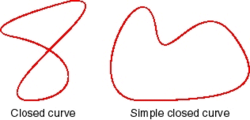Intuition
 You can create a closed curve of length
l
by drawing any path of length
l
that connects to its start. Some examples are given above.
You can create a closed curve of length
l
by drawing any path of length
l
that connects to its start. Some examples are given above.
Let the maximum area for a closed curve of length 1 be A . Find ⌊ 1 0 0 0 A ⌋ .
Clarification: the symbol ⌊ x ⌋ denotes the largest integer less than or equal to x .
The answer is 79.
This section requires Javascript.
You are seeing this because something didn't load right. We suggest you, (a) try
refreshing the page, (b) enabling javascript if it is disabled on your browser and,
finally, (c)
loading the
non-javascript version of this page
. We're sorry about the hassle.
2 solutions
Great! An intuitive way of explaining why it must be a circle is to imagine filling a 2D rope with a 2D gas. We know it will fill up until it reaches a point where it cannot expand anymore, which is a circle.
Log in to reply
I like that idea! The same intuition holds in "proving" that a sphere encloses the largest volume among all closed surfaces of a given area.
Nice argument (+1)
That's really cool. I immediately figured it would be a circle but could not explain why in a simple way. That a very cool way to think about it.
It should have accepted 79 or 80 based on rounding.
Log in to reply
The ⌊ . . . ⌋ symbol indicates the floor function , (aka greatest integer function), which returns the greatest integer less than or equal to the "enclosed" quantity. Then ⌊ π 2 5 0 ⌋ = ⌊ 7 9 . 5 7 7 4 7 . . . ⌋ = 7 9 .
Curve with maximum area should be circle (intuition). As length is 1, therefore we can write circumference is 1
Radius r = 2 π 1 , thus area A = π r 2 = 4 π 1 .
So [1000A] = [ π 2 5 0 ]= 79
How does it possible the answer be in integral form when an integer is divided or multiplied by an irrational number? The answer is approximately 79.6, then why was it not taken as 80?
Our intuition would tell us that the curve with maximum area will be a circle, and this is in fact correct. A circle of circumference 1 has radius r = 2 π 1 , and thus an area of A = π r 2 = 4 π 1 .
This gives us a final answer of ⌊ 1 0 0 0 A ⌋ = ⌊ π 2 5 0 ⌋ = 7 9 .
This concept is known as the isoperimetric inequality , two proofs of which are provided in the link.